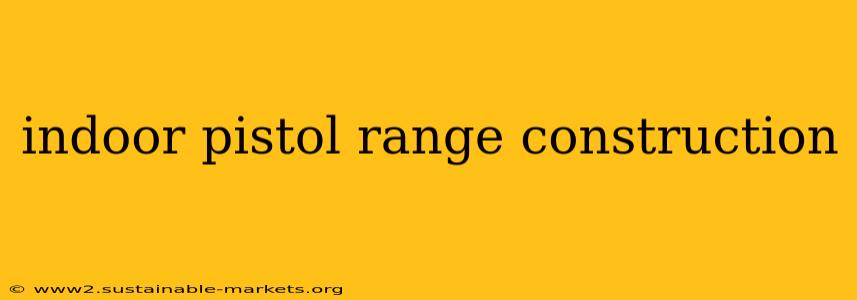Building an indoor pistol range requires meticulous planning and execution to ensure safety, compliance, and profitability. This comprehensive guide delves into the crucial aspects of indoor pistol range construction, from initial planning to final inspections. We'll cover everything from design considerations to choosing the right equipment and materials.
Phase 1: Planning & Design – Laying the Foundation for Success
The foundation of a successful indoor pistol range lies in thorough planning. This phase is critical and often overlooked. Neglecting proper planning can lead to costly rework, safety hazards, and regulatory issues.
1.1 Site Selection and Zoning Regulations:
Choosing the right location is paramount. Consider factors like:
- Zoning: Ensure the location is zoned for commercial use and allows for firearm-related businesses. Local ordinances vary significantly, so thorough research is essential.
- Accessibility: Select a location with convenient access for customers and ample parking.
- Utilities: Confirm the availability of sufficient power, water, and sewage lines to meet the operational needs of the range.
- Noise Considerations: Proximity to residential areas requires careful consideration of noise mitigation strategies.
1.2 Designing for Safety and Functionality:
The design should prioritize safety and efficient workflow. Key aspects include:
- Shooting Lanes: Determine the number of shooting lanes based on projected demand and space constraints. Standard lane widths are typically 10-12 feet.
- Backstop Design: This is the most critical safety feature. The backstop needs to be robust enough to stop projectiles and prevent ricochets. Materials such as steel plates, specialized bullet traps, and high-density concrete are commonly used. Consider the caliber of firearms to be used.
- Ventilation: Adequate ventilation is crucial to remove lead dust and particulate matter, protecting both staff and customers. A high-volume, low-velocity (HVLV) system is recommended.
- Lighting: Bright, even lighting is essential for safety and comfort.
- Layout: The layout should allow for smooth customer flow, including check-in, range access, and exit. Consider the inclusion of a retail area for firearm accessories and ammunition.
Phase 2: Construction – Building a Safe and Efficient Environment
This phase involves the physical construction of the range. Precision and adherence to safety standards are crucial.
2.1 Building Construction:
- Walls and Floors: Construction materials should be durable and capable of withstanding the impact of projectiles. Reinforced concrete is a popular choice.
- Ceiling Height: Sufficient ceiling height is necessary for safety and projectile trajectory. A minimum height of 12 feet is generally recommended, but higher ceilings are preferable.
- Electrical Work: All electrical work must adhere to local codes and regulations. Proper grounding and protection against electrical hazards are paramount.
- Plumbing: If restrooms and a cleaning area are included, proper plumbing and drainage are necessary.
2.2 Installation of the Shooting Range Components:
- Backstop Installation: The backstop must be installed precisely and securely to prevent projectile penetration or ricochets. Professional installation is highly recommended.
- Ventilation System Installation: The ventilation system should be designed and installed by qualified professionals to ensure optimal performance and safety.
- Lighting Installation: Install lighting fixtures that provide adequate illumination for safe and comfortable shooting.
- Bullet Trap Maintenance: Regular maintenance is vital to ensure the ongoing effectiveness of the bullet trap.
Phase 3: Licensing, Permits, and Inspections – Navigating the Regulatory Landscape
Operating a legal and safe indoor pistol range demands strict adherence to local, state, and federal regulations.
3.1 Obtaining Necessary Permits and Licenses:
This will vary significantly by location. Contact your local authorities to determine the required permits and licenses. Expect thorough background checks and safety inspections.
3.2 Safety Inspections:
Thorough inspections are crucial to ensure that the range meets all safety standards. Engage qualified professionals for these inspections.
3.3 Insurance:
Secure appropriate liability insurance to protect against potential accidents and lawsuits.
Conclusion: A Successful Indoor Pistol Range Requires Careful Planning and Execution
Building a successful indoor pistol range is a complex undertaking. Careful planning, adherence to safety standards, and compliance with regulations are crucial for a profitable and safe operation. Remember that professional guidance from architects, contractors, and safety experts is invaluable throughout the entire process. This guide provides a framework; seeking expert consultation is strongly recommended to ensure a successful and compliant project.

